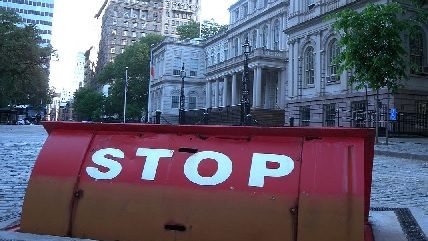Sign Regulations and the Threat to Free Speech
City planners won't let private citizens put bright red signs on their own lawns.


In 2006, auto shop owner Wayne Weatherbee decided to expand his business by purchasing a vacant lot that had once held another auto shop dating back to the 1940s. But zoning officials in the city of Clermont, Florida, determined that Weatherbee's plans for the lot clashed with the city's aesthetic agenda and zoning regulations, so they asked him to first obtain a special permit before doing what he wanted with his own property.
Rather than apply for said permit, Weatherbee posted a dozen signs on his lot criticizing city officials, including the city manager and chief of police. One sign proclaimed: "Intimidation/Harassment—Selective Law Enforcement—False Arrests—False Documents—What's Next? At Least They Haven't Taken My Freedom Of Speech YET!"
Predictably, the city's next move was to take away Weatherbee's freedom of speech.
Since the 1950s, the United States Supreme Court has unfortunately held that basic constitutional liberties should yield to the government's self-proclaimed interest in tailoring local aesthetics. Writing for a unanimous Court in 1954, Justin William O. Douglas upheld Congress' decision to eliminate a supposedly blighted African-American neighborhood in Washington, D.C.
"The concept of public welfare is broad and inclusive," wrote Douglas, and it includes "aesthetic as well as monetary values." It was the government's prerogative to "determine that the community should be beautiful as well as healthy, spacious as well as clean, well-balanced as well as carefully patrolled," according to Douglas.
Granted broad license by this and subsequent Supreme Court decisions, it's no surprise that local governments throughout the country have used aesthetics to justify all sorts of bullying, harassment and censorship in the name of the public good. Small businesses often bear the brunt of local aesthetics controls, as city officials seek to impose their own views of what looks and feels good on the community at large. But even with the Supreme Court's endorsement of such nonsense, the lower courts still occasionally recognize First Amendment restrictions on the state's aesthetic brutalism.
In December 2009, Clermont cited Weatherbee for violating city ordinances governing the display of signs on commercial property. All signs required permits unless they fell into an exempt category. There was an exemption for "temporary political signs," but that only applied to "a sign or poster advertising either a candidate for public office or a political cause subject to election." It did not cover Weatherbee's signs, which attacked public officials outside of the electoral process.
The Clermont Code Enforcement Board decided to fine Weatherbee $75 for every day he refused to take down the sign. His response was to file suit, and in March of this year, he finally prevailed. U.S. Senior District Judge William Terrell Hodges ruled in Weatherbee's favor, finding that Clermont's sign code was unconstitutional. Hodges chided city officials for arbitrarily distinguishing between purportedly political messages and other types of signs.
The code was "not narrowly drawn to satisfy a compelling government interest," wrote Hodges.
For their part, city officials put forth aesthetic considerations as the justification for censoring Weatherbee. And indeed, Hodges did acknowledge that "the City has the right to generally promote aesthetics." But there was no explanation—either in the code or from city officials—concerning how the censorship of non-commercial political signs accomplished that goal. Clermont restricted businesses to one "non-commercial sign" while allowing an unlimited number of signs for other purposes, such as directional or parking information. The city could not explain why some signs were inherently more visually desirable than other signs that just happened to advertise messages critical of city governance.
Unfortunately, Weatherbee's victory is the exception rather than the norm—especially in cases where such controls are justified on the additional ground of historic preservation. As Justice Byron White observed in a 1981 Supreme Court opinion, a city's "interests in aesthetics and historical authenticity are sufficiently important that the First Amendment" should not stand in the way. In other words, while the government may not impose content-based restrictions on the narrow category of political speech, it is free to discriminate against any artistic or aesthetic viewpoint with which it finds fault.
In practice, this has often yielded absurd results. In Thomas Jefferson's hometown of Charlottesville, Virginia, a Board of Architectural Review appointed by the city council has near-total aesthetic control over specific buildings and roads designated as historic. In 2012, the board forced local artist Matt Pamer to change his design for a mural on the side of a restaurant. The problem? Pamer wanted to use too many colors. The board demanded that Pamer eliminate the use of "bright" reds and yellows and confine himself to a palette of more toned-down blues and greens.
The board justified its actions by citing the need to preserve the historic aesthetics of the West Main Street neighborhood where Pamer painted his mural. But in reality, there is little historic or visually interesting about the area, which is merely a corridor between Jefferson's University of Virginia and Charlottesville's downtown shopping district. West Main Street's history was that of a stomping ground for car dealerships and repair shops until recent gentrification attracted trendier restaurants and artists like Pamer. (Indeed, the building that features Pamer's mural is currently an upscale seafood restaurant.)
Pamer and his Charlottesville patrons went out of their way to appease the city and not complain about infringements of their free speech and property rights. But in other cities, local businesses are taking a stronger stand against aesthetic controls. The Institute for Justice recently reported on unrest in Raleigh, North Carolina, where businesses are working to change the city's draconian sign laws. Among other things, the city limits all signs to just four colors. One businessman told the Raleigh News & Observer that such a policy "makes the signage very ineffective, and it becomes very homogeneous."
A city councillor, Mary-Ann Baldwin, disagreed.
"The sign ordinance has gone a long way to making our city attractive," said Baldwin in a statement.
In the eyes of government officials—for whom bright colors and unlicensed protest signs are intolerable symbols of urban blight—liberty will never be as attractive or aesthetically pleasing as conformity. True beauty seems to come from an unquestioned reverence for an arbitrary point in history, according to the state.
The justices of the Supreme Court—sitting in their "classical Corinthian" temple in the planned city of Washington, D.C.—may not see the constitutional problem with any of this. But the First Amendment is not just about protecting newspaper editorials or campaign advertisements. It applies to all forms of individual and artistic expression, no matter how bright the colors used.
Show Comments (72)